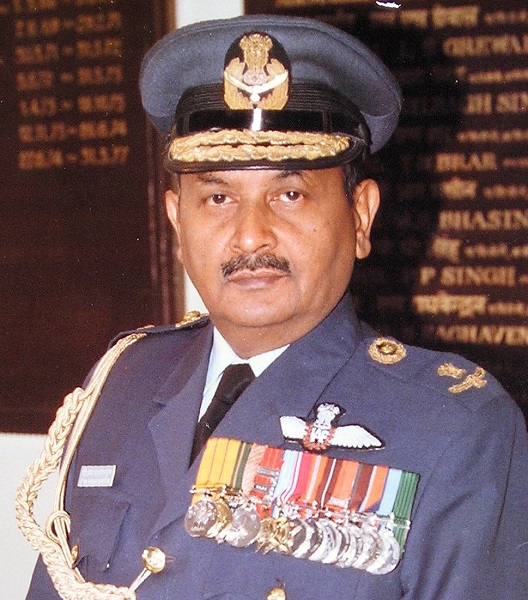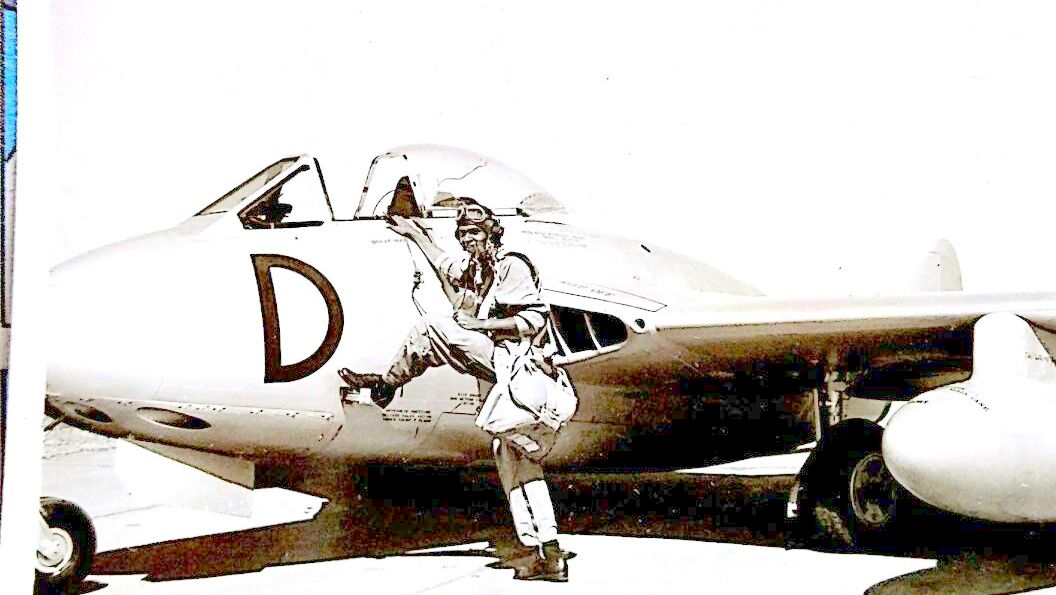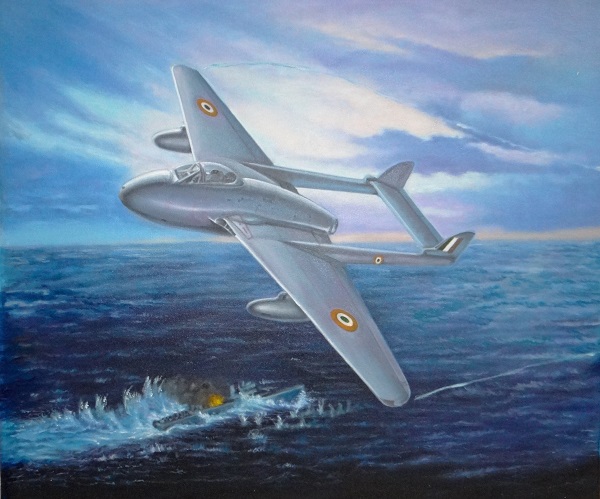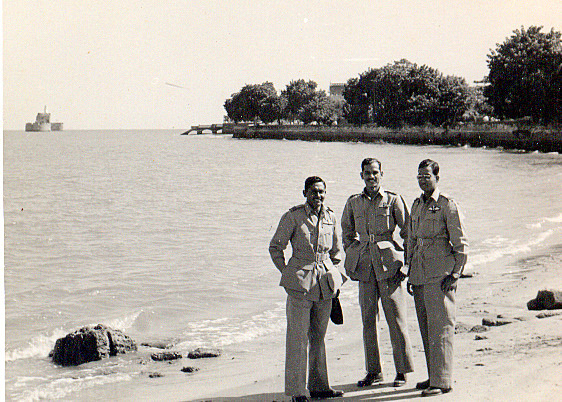 “Operation Vijay” – (Goa Operations – Diu Sector)
“Operation Vijay” – (Goa Operations – Diu Sector)
The episode of blowing up at sea of a Portuguese Patrol Boat laden with explosives off Diu by IAF on 18 Dec 1961. First person account of the sinking of NRP Vega during the Diu Operations in 1961. Air Marshal P M Ramachandran, PVSM AVSM SC VM narrates his story of that eventful sortie from 18th December 1961.
On 15th August, 1947, British rule of India came to an end and India became an independent sovereign state. All Princely States and French colonies in India were integrated into the Indian Union in due course except the Portuguese colonial pockets of Goa, Diu and Daman. The Portuguese Government was adamantly refusing to hand over these territories to India and finally, the Indian Government ordered the Armed Forces to liberate these territories by military action. Army, Navy and Air Force were tasked as appropriate. However, this operation was termed a “Police Action” for diplomatic expediency and hence Gallantry Awards were given by civil equivalents only. It was code named “Operation Vijay” and was launched on 18th December 1961 and successfully completed in just 40 hours. It ended officially with the Portuguese Governor General Manuel AntonioVassalo de Silva signing the Instrument of Surrender to the Commander of Indian Forces, Maj Gen K.P.Candeth at 2030 hours on 19th Dec 61. Thus the 451 years of Portuguese rule over Goa came to an end.
18 December, 1961
For Operation Vijay, Armament Training Wing (ATW) at Jamnagar was made responsible for offensive air operations and close air support to the army in the Diu Sector. Its resources comprised of its own (PAI) Pilot Attack Instructors’ School fleet of Vampire jet fighters and two squadrons (No 4 Sqn with Toofani aircraft and No 23 Sqn with Gnats) both undergoing training and assessment at Jamnagar at that time. Vampires and Toofanis were used for offensive ground attack and Close Air Support operations and Gnats for Air Defense of the air base and area of operations.
I was a Flt Lt posted as an Instructor in the PAI School, immediately after having undergone the PAI course earlier in 1959. This had given me an excellent opportunity to hone my skills in attack tactics and accuracies, which played a decisive part in my success in the operation I have recounted below.
On the morning of 18 Dec 1961, the first day of the commencement of hostilities, I was detailed to lead a section of two Vampire Mk 52 aircraft for an offensive Recce / Close Air Support mission over Diu with Flying Officer Bhavani Shankar (Boondi) as my wingman. Each aircraft was armed with four 60 lb Medium Rocket Projectiles (MRPs) under its wings and its four Aden 20 mm cannons were loaded with 100 rounds of ball ammunition per gun. ATW, being a training outfit, did not have “High Explosive” (HE) ammunition for the guns.
 |
| Flt Lt P M Ramachandran about to mount on a sortie in a De Havilland Vampire Mk 52. The pilot has to strap on the seat type parachute before climbing in When sitting, the parachute pack fits into the bucket. It also serves as a cushioned seat. “Baling out” from the Vampire involved jettisoning the canopy, unbuckling the seat straps, and getting out with the parachute pack, and pulling the rip cord to open the parachute ! Obviously a reasonable amount of time and altitude is required to bale out successfully. |
We took off from Jamnagar in the early hours of the morning and, on reaching the operational area near Diu, I established radio contact with the Forward Air Controller (FAC). As assigned by him in consultation with the local Army Commanding officer, we attacked with rockets the Portuguese gun bunkers covering the only connecting causeway between the island and the mainland to the North.. These were effectively blocking our army advance. Our rocket attack caused significant damage to the target and more such attacks by other sections followed to neutralise the opposition.
Since our aircraft had unspent gun ammunition, I asked the FAC for a suitable secondary target. I got an odd response from the FAC to fire at “Diu Town” and my repeated requests for a specific target got the same answer. As it was patently ill-justified to harm our own civil population and was not a designated military target of the operations, I decided to ignore it and flew around searching for a suitable military target.
I then noticed a fast patrol boat of medium size heading out from the Fort on the eastern side of the island towards an Indian Navy ship standing about two miles off shore towards the South West. (The ship was INS Delhi as revealed later). I then descended to about 200 feet and flew towards the patrol boat from East to West to identify whether the boat was friendly or hostile. As I was closing in, the boat and the Fort opened fire at me. This was very evident as the enemy had interspersed “tracer” bullets in their gun ammunition and hence the trail was clearly visible to me. It was too late to open fire from my side and I passed over to the west luckily unharmed. My No 2 was also not hit.
I immediately declared the target as hostile and decided to attack. I planned to execute the attack heading towards the North-east so that I could avoid flying over the gun emplacements of the Fort and, if my aircraft was hit, I might be able to bail out over land in Indian territory behind our Army lines. Accordingly, I turned around in a left hand circuit going over the sea at low level and went into a steep pull-up attack rolling in towards the target in a 10 to 12 degree dive. Although the patrol boat had now started evasive zig-zagging whilst firing its guns, I held my aim steady and ensured a long burst from my guns hit the target.
When I reached a safe distance away, I turned around and saw the patrol boat had come to a standstill but had not been destroyed, since the ball ammunition of our guns had no explosive characteristic. I glanced at my fuel gauge and decided that I could squeeze in one more quick attack.
I used a tighter attack pattern starting the firing at a slightly longer distance and kept all four guns blazing till pulling out of the dive. The stationary target made aiming easier to put the whole burst right into the target. It was when I glanced back after the pull-out that I saw a huge column of smoke in mushroom form and wondered why there was such a huge explosion.
Since the fuel state was a cause of concern, I set course towards base. My wingman Boondi also was keeping up well with me all the while. We climbed up to medium height and using optimum fuel consumption settings landed safely at base with rather low fuel state. Our flying time for the sortie was over one hour. On inspection, my aircraft was seen to have sustained some minor damages repairable on site.
We then reported to Sqn Ldr (Nobby) Clark, the Officer In Charge PAI Flight and Wg Cdr (Mickey) Blake, the Chief Instructor for debrief and recounted the happenings. The pilots of other missions over the area also reported their observations of the smoldering target that was visible from long distances.
The whole episode of 18th was in full view of our Navy’s INS Delhi and our Army on the mainland shores with whom our Air Force FAC was attached. I am sure they would have made their reports to their respective higher echelons as observed by them.
This was the very first experience for almost all of us and the realisation that we were in a real shooting war with a real enemy (that was far from the usual range practice) started to sink in. There was no talk of any Gallantry Award at all as none of us had any familiarity of this aspect.
Log Book entry for Goa Operations from Air Marshal Ramachandran. The aircraft’s identity is shown as IB827. Note the news clipping from 1961 about the sinking of the boat
Rest of the Action:
On 19 Dec, I carried out one more sortie over Diu of “Offensive Recce“ on a Vampire T.55 2-seater aircraft with Flt Lt Amio Kumar (Laddoo) Sen, also an instructor at PAI School. This was a tame affair in comparison with my first sortie as Portuguese resistance had all but crumbled by this time.
One of the newspapers reported the next day – “A steam launch with ten Portuguese soldiers was fired upon by the Indian forces and destroyed. Nine of the ten soldiers were killed. The survivor was captured. The fighting raged for 16 hours.”
Aftermath
A few days after Ops Vijay, I left to undergo a one year course at The Empire Test Pilots’ School (ETPS), Farnborough, UK. In Sep ’62, I received an envelope from Air HQ and, to my great surprise, found it contained letters congratulating me on the Award of ‘Ashoka Chakra – Class III’ from four big-shots – Air Mshl A.M.Engineer D.F.C, Chief of the Air Staff, Air Vice Mshl Arjan Singh D.F.C., Air HQ, Air Vice Mshl E.W.Pinto AOC-in C, Operational Command IAF Palam and Shri O.Pulla Reddy, Defence Secretary. This was the first time I heard about the award, which no doubt made me happy and proud. I wrote a short reply to AVM Arjan Singh expressing my gratitude and assurance for continued dedicated service. After my return to India, I received the Award formally from President Dr S. Radhakrishnan at the Investiture Ceremony held at Rashtrapati Bhavan on 8th Oct ‘63.
Mine was the only Gallantry Award for IAF in respect of Ops Vijay.
The short citation for the Award Ashok Chakra Class III (read out in full at the Investiture those days), later renamed “Shourya Chakra” reads as below.
“On 18th December 1961, Flight Lieutenant Ramachandran was detailed to lead a section of two Vampires in close support of the ground forces in Diu. While flying over the area, he noticed a patrol boat heading towards an I.N.Ship which was about two miles from the shore. On his own initiative, he decided to fly low to survey the patrol boat when the Portuguese opened heavy fire at his aircraft from the boat as well as from Diu fort. Undeterred by the hostile fire, he attacked and blew up the patrol boat which was full of high explosives. During the attack his aircraft was damaged by hostile fire. Flight Lieutenant Ramachandran displayed courage and initiative of a high order.”

An artist’s depiction of the event – this painting hangs in the corridors of Air HQ, Vayu Bhawan, New Delhi.
Reflections
I initially believed significance can be attached to the patrol boat being full of High Explosives, boat moving towards I.N.Ship (Delhi) and capture of a soldier from the boat. From an interrogation of the captured soldier, and later of other surrendered Portuguese, it would indicate that the patrol boat was on a mission to ram into the stationary I,N.S Delhi gaining proximity by false pretentions. That, if successful, would have been a serious blow as in the case of U.S.S. Cole in Aden harbour in Yemen on 12th Oct 2000.
Since it first happened, a good amount of literature has been published from the Portuguese side. The boat that I attacked was “N.R.P Vega”, a micro warship equipped with a 20 mm cannon with a crew of eight. It was commanded by 2nd Lt Oliveira e Carmo of the Portuguese Navy. He had received orders to engage the Indian forces on the morning of December 18th, and though outgunned, he set sail to engage the INS Delhi. I encountered the patrol boat en-route and the exchange of fire took place. Oliveira e Carmo was hit in the first pass and he died heroically at helm as the Vega went down. Another seaman Ferreira died in the same attack – while a third Seaman Jardino died of injuries later. Five of the Vega’s crew survived the action.
Very unfortunately, our only fatal casualty during Ops Vijay occurred when I was taxying-in to the dispersal on 19th. I turned in to the parking bay following the Marshaller’s bat signals. When we climbed down the ladder, we learnt that our “Chiefy” had been hit by the wingtip on his right temple. He was standing on the grass shoulder of the taxiway signaling to the Marshaller. It was a pity he was standing just an inch closer than safe and was focused on the Marshaller. He was awake throughout the previous night supervising the arming and preparing of all aircraft for the early morning sorties. Lack of sleep and rest possibly resulted in a slight misjudgment of distances. The perspex cover of the wing tip navigation light was found cracked. Flt Sgt Swamy was a dedicated and knowledgeable technician held in high esteem by all the air and ground crew. It was a great loss to the base and his funeral was attended by all officers and men on the station which was a fitting tribute to him. In a spontaneous gesture, all personnel made generous donations to a fund raised to provide substantial immediate support to the bereaved family.

A couple of days after the surrender, some of the Pilots visited DIu to see the damaged targets. This picture was taken on the Northern beach. The structure in the sea channel behind them can be located on the maps. (L -R) The Author – P M Ramachandran, Flt Lt S.B.Bhagwat (Later shot down over Sargoda in 1965 war), Fg Offr N.Venkatramani (A Transport pilot of Target Towing Flight, TTF, Later a senior pilot of Air India).
The Author, Air Marshal P M Ramachandran 4973 GD(P), served in the Indian Air Force from 1955 till his retirement as Vice Chief of Air Staff in 1993. In addition to the Shaurya Chakra (Orig Ashoka Chakra Class III), he is a receipent of the Vayu Sena Medal, the Ati Vishist Seva Medal and the Param Vishist Seva Medal.
Hear the story in his own words on the Blue Skies Podcast Episode
All contents of this page are the copyright of the Author. The Painting at Air HQ is copyright of the Indian Air Force.
